Pests are a plant’s worst enemy. From aphids to snails, grasshoppers to fungi, these organisms can infest their chosen plant and either hamper its development or destroy it completely.
In practice, there are several methods of pest control that you can use, ranging from biological methods (introducing predators to prey on your pests) to man-made chemicals to keep your plants safe.
But many of these techniques are either impractical for daily use, or leave our plants coated in chemicals that we don’t want to consume.
And yet, a safer solution could be hiding in your pantry: a homemade bio-pesticide from onion or garlic skins.
Related: How To Protect Your Garden From Pests And Diseases
Home Made Bio-Pesticide
Bio-pesticides are organic pesticides that make use of the defense mechanisms developed by certain plants, and applying those organic chemicals to your garden. This results in a non-toxic technique to control pests, that is safe for the plant and for you.
One of the best and easiest bio-pesticides you can make at home is based on common kitchen waste: onion skins.
You can use skins or dry leaves from any member of the onion family, including white onions, shallots, garlic, or even leeks. Repurposing household waste in this way is great for sustainability, and means you can produce as much pesticide as you need for zero cost.
Onion and garlic skins contain potassium, magnesium, phosphorus, and zinc which are great for plants’ growth and development. But they also contain sulfur compounds: allicin in garlic, and lacrymatory factor in onion, which is why cutting onions makes your eyes water.
These sulfur compounds are toxic to insects, parasitic nematodes, slugs, snails, and fungi. They are also effective insect repellants, meaning you don’t just kill the pests on your plants today, but keep them away in the days to come.
How To Make Onion-Garlic Skin Pesticide
The first step is to collect some onion and garlic skins.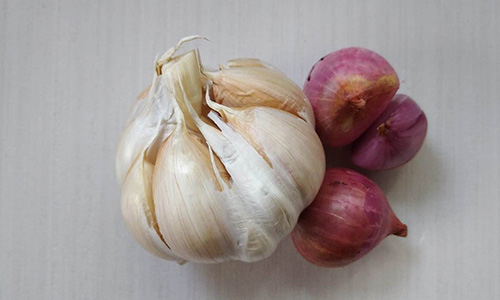
Simply strip away the dried, outer layers: for this demonstration, we are using the outside skins of some garlic and shallots.
You can also collect the skins whenever you are cooking, and store them in a dry container or in the freezer until you are ready to use them.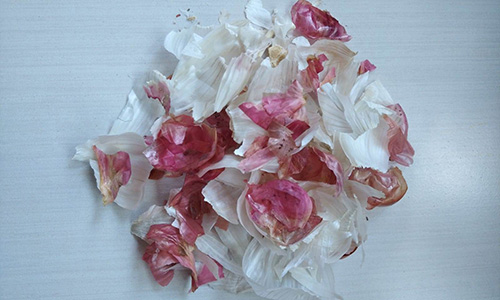
Put the skins into a transparent bottle or container. Add some water, leaving a little space at the top of the bottle.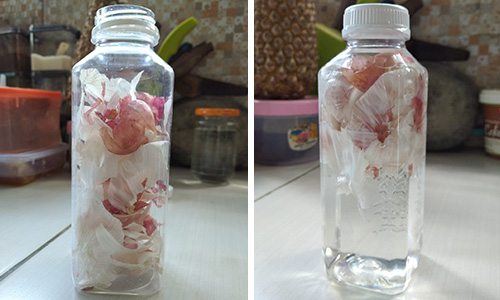
Keep the bottle at room temperature for 2 – 3 days. When the biopesticide is ready to use, the color of the liquid will turn brown, and the onion and garlic skins will form a mass at the bottom of the bottle.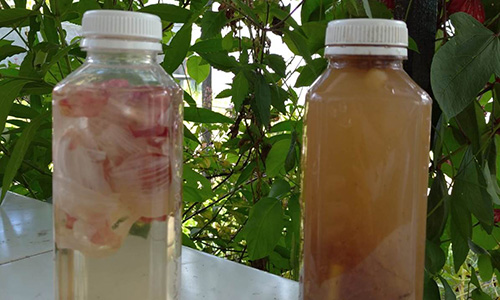
When you open the bottle, there will be a strong smell – this is from the sulfur compounds that are going to kill the bugs.
Using Your Homemade Pesticide
If you use the pesticide on infested plants, the easiest way to apply it is to transfer the pesticide to a spray bottle.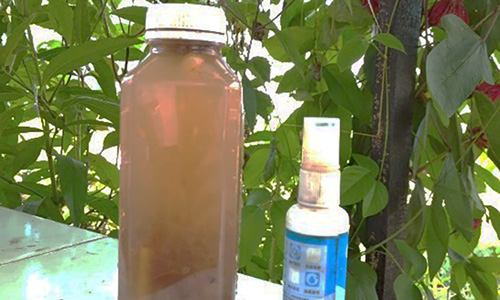
If you want to treat an existing infestation, you can target your pesticide spray onto the parts of the plant that are infested. Alternatively, if you’re using it as a repellent, then you can apply broadly to the whole plant.
Related: Make Your Own Peppermint Oil – The Best Insect Repellent
The best time to do this is in the early morning or evening. Try not to spray the plant in the middle of the day in hot weather, because it could make the plant wither.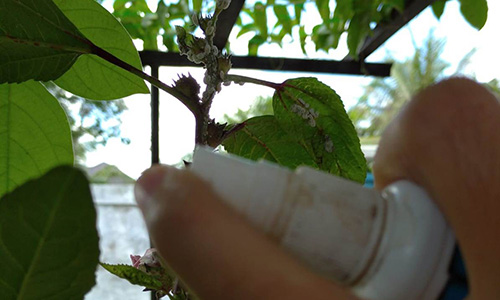
The effects are noticeable within a few hours.
The part of the plants that you sprayed with the pesticide will stay healthy, while the pests that were attacking the leaves and fruits of your plant will dry out and die.
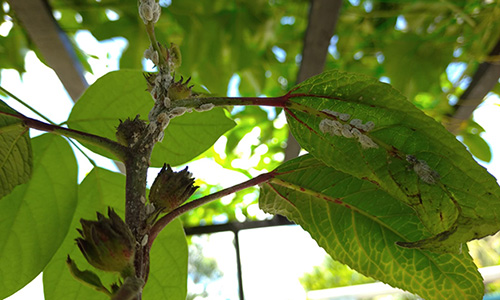
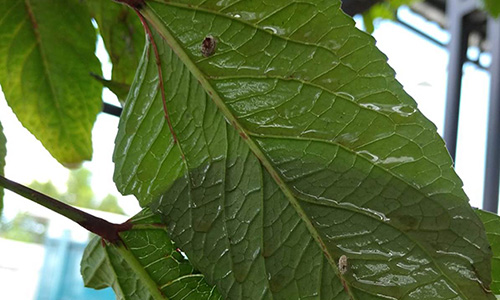
What Pests Can Be Killed With Onion-Garlic Skin Pesticide?
In a review of published research into the pesticidal properties of garlic, scientists have identified that the allium sulfur compounds in this simple onion and garlic skin recipe kill a range of pests.
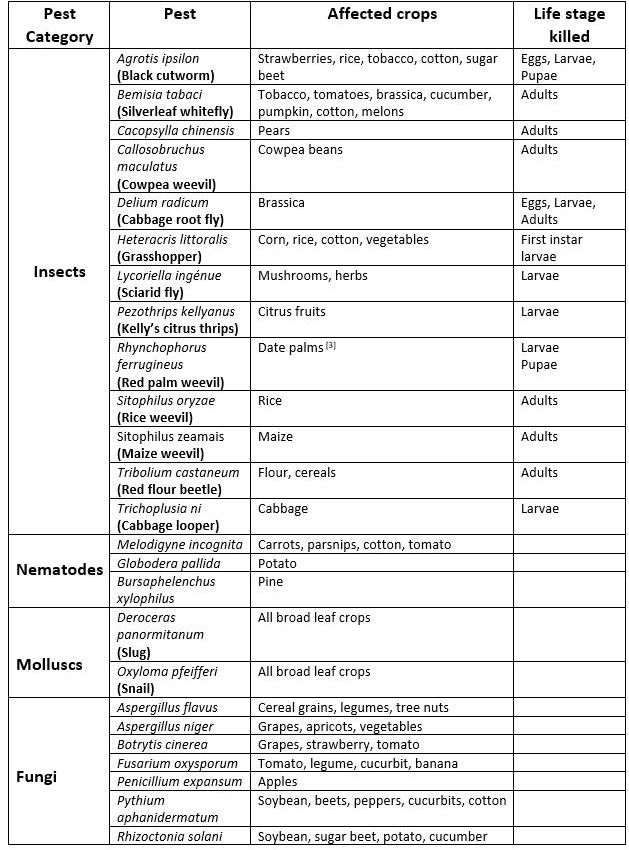
This concoction can also be used as a repellant and pesticide for other types of pest, including mosquitoes, ants, and bedbugs.
Pour a small amount of your pesticide into a dish, and put it in the room or area that you want to keep free of these insects.
As the aroma from the pesticide fills the room, these pests will make a sharp exit.
Related: Homemade Traps for Garden Pests
Warnings
1. Make sure to keep this mixture away from pets, as onions and their relatives can be toxic to dogs and cats.
2. The smell of this pesticide is very pungent. Although the aroma usually dissipates within 5 to 10 minutes after you apply it to plants, if you are using it in a dish to repel mosquitoes then the smell will linger for longer.
This may also be a good repellent for unwanted visitors of the human variety!
Bottom Line
Onions, garlic and their cousins have several uses in SHTF preparation, in traditional medicine, maintenance of household appliances, and even as a rooting agent for cuttings.
But this simple homemade pesticide is one of the cheapest and most effective pesticides you will find in your pantry.
You may also like:
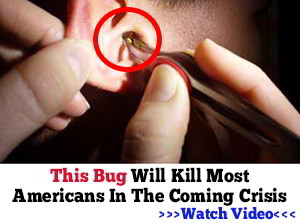 How Growing Your Own Vegetables Can Get You Arrested
How Growing Your Own Vegetables Can Get You Arrested
What Happens If You Pour Sugar Into A Carved-Out Onion (Video)

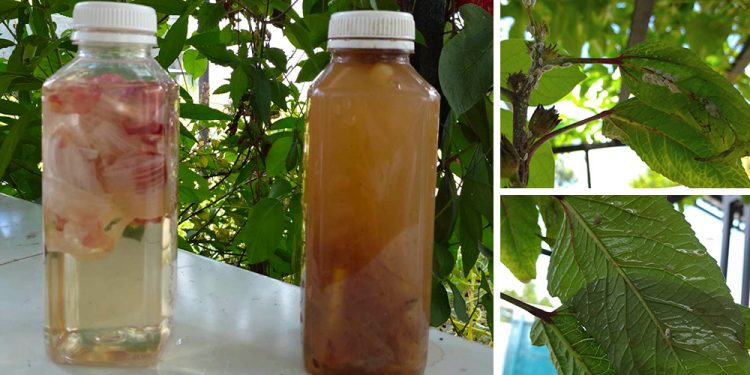




















This is super helpful. Thanks for sharing this! Will this work for squash bugs or is there something else better. I’ve been using garlic/jalapeno pepper tea but they seem to not be too affected at all and destroyed a lot of my squash and pumpkins.
Thanks
My fig trees are suffering so much with the fungi/dark spots on the leaves, then they turn yellow and die…please help me with this one.
It is probably rust due to too much rain, or watering and humidity. I have had it 3 years in a row. Liquid copper fungicide is the prevention. From what I have read you cannot kill the rust once in the fig system. You can only prevent it. And I have found if fruit is on there when it gets the rust, the figs will not ripen. Very frustrating!!
I have two Plumb trees (in upstate SC, and they have developed a (toothpaste line of) black puffy fungus on the branches. It looks like burnt marshmallows (to give you an idea of what it looks like) I have tried different chems and nothing helps
Ooops, forgot to comment on your book….bought your book…. love it….
Love this information, thanks for sharing. Please don’t stop publishing this helpful information.
Great idea! Most garlic spray recipes throw out the skin and use the bulb, but the spray is strong and has to be diluted. This way you get an effective spray with less chance of foliage burn, and you get to eat the garlic.
Dusting sulfur was a major gardening tool before organophosphate pesticides, effective on a lot of disease problems, worms, and mites. Back in the eighties I started using a product called Bioform, an organic foliar fertilizer and disease spray that has sulfured molasses and garlic tea, giving it a sulfur content of 3%. I spray it on plants like fruit trees and roses after pruning them in January, once a week, the sulfur keeps diseases from getting a start and kills any mites or eggs that might be present. I spray it on veggies as soon as planted, once a week, the spray is also a complete fertilizer so it gets everything off to a great start. The main thing to remember is to stop using this spray once the night temperature starts getting into the upper 60s and flirting with 70 or you can get some burning on the plants. A similar product is called Garrett Juice which can be purchased or make your own because crusty old Howard Garrett has always kept the home recipe on line. The cool thing about the garlic tea in the article is it’s mild enough to use in warm weather after the other products can become risky on some plants.
Squash bugs overwinter in organic litter like leaves, clean up the area you’re going to use for squash then use Bioform as a soil drench. This will help but the squash bug is a bug that likes to travel, best control during growing season is a soap spray like SaferSoap.
Start spraying Bioform or Garrett Juice on your fig tree in late winter when the buds swell, once a week until the nights start to warm up, this will be a big help controlling disease on Fig or any plant.
Judge: Plant coyote (buffalo) gourds near the patch. Bugs prefer them to squash and pumpkins but the gourds don’t seem to mind. They don’t cross with squash or pumpkins, and if the winter is warm enough, they should come back from the roots. niio
Thank you Judge. I appreciate the information you’ve given me to take care of the squash bugs and pumpkings.
There are 2 plants commonly called coyote gourd. Common one in Texas is C. foetidissima, also called stinking gourd because the leaves and fruit stink. It has a simple lance shaped leaf. The common one farther west appears to be C. palmata, it has a simple palmate leaf. I have never run across it, does it also smell bad? Other than the leaves both plants are vigorous low growing vines with baseball sized fruit. Is the western one more palatable? I read that the large tubers have been important in ritual and healing, but nothing specific. The leaves of stinking gourd have been used as insect repellent and I have read the tuber will give one the worst case of chorro anyone ever saw or heard about.
Judge, both stink. the palmated leaves gourd isn’t all that bad. It’s in the garden and growing all over, but no fruit. Seeds of both are supposed to be very high in protein and no stink but are bitter. Best use for them is to attract squash borers and so on away from squash. niio
WHY would anyone give a thumbs down to INFORMATION?
Leave your hate off this forum.
Will this work on the hemp plant?
@ Runner1
If I were going to use the hemp, for only cooking, then I would use this product.
It is all natural.
If I were going to use the hemp for smoke, then no.
Keep it natural.
remember, eating is one thing, and smoking is another.
This is perfect timing! It’s time to bring plants in around here, and I just happened to notice my bay laurel is infected this morning. I’m about to peel some onions! Thank you! This information will be most helpful!
CC: what’s wrong with the bay laurel? I lost one to the devil winds (20+ MPH, 4% humidity, 100+ F) the other one is in a place shelter from the wind but still died back. Recovering, but slowly. niio
Red – Foliar feasters, psyllids, and they thought they’d pull a fast one on me but I learned long ago to always look at the underside of the leaf! Perhaps yours would be better has a houseplant given the conditions in your neck of the woods. Mine is coming in soon.
CC: I was wondering about your tree. The new one is alive, on the east side of the house. This area is like Mediterranean, and bay should do well. The problem is the wind+temperature+low humidity, and likely because of all the wildfires. The last few years were so bad over half the prickly pear cactus died. The capulin cherry (was originally brought here from spain as seeds) is fine. But, that was bought in April. Other trees bought before that look unhealthy, 2 died. What gave the cherry a better chance was we got very early summer rains. Not a lot, but it stopped most of the fires. niio
I had green worms eat the leave of my first attempt at potatoes this summer. I’m going to give them the italian treatment next summer. Thanks for this article. Very helpful
I’d be concerned about the effect this has on bees. I’ve been using Neen oil as one of my neighbors is a beekeeper and that was his recommendation.
Daniel: None to the best of my knowledge. Excepty, the smell might chase them off. niio
If you want to know more about Neem Oil, Oregon State Pesticide Center has a lot of information:
http://npic.orst.edu/factsheets/neemgen.html. Apparently Neem Oil only affects bugs that chew on plants. They have to ingest the oil. It apparently is relatively safe to use around humans. Read the article. Bees and other pollinators don’t ingest the plants and thus are safe from its effects according to the article. The question that arises in my mind is that while bees don’t actually eat the foliage, they do something with the nectar that the plants contain in order to make honey. I haven’t investigated just exactly what it is that they do with the nectar but I seem to recall that they ingest the nectar of the plants. ?????
I guess it’s back to Entomology for Boneheads 101 for me.
Honey is actually digested regurgitated necter. Are you sure you wanted to actually know that? Lol. Actually I love honey. Love to chew on honeycomb. Honey is a savored treat on fry bread, enjoyed mixed with butter and spread on my morning toast, or mixed with peanut butter for a lunch sandwich. Honey in hot tea is soothing to a sore throat or a bit on a spoon to ease a cough. Amazing stuff.
Yo, I like this! But, the only time I have a problem with bugs is from too much nitrogen in the soil. But, in the soil I have sowbugs, and they destroy a lot of seeds and seedlings. the best bet for them is chickens or turkeys. Fence off one bed at a time and let them in it for a few days. niio
Very good article!
I spent soooo much effort last summer trying to get my thumb green – started w/seeds in tiny pots, watered every day till they outgrew the tiny pots so transplanted to bigger little pots (3 weeks of growth) Tilled the perfect place in the yard (started 2 years earlier w/manure) Finally got them in the ground and 1 devastating rain over 3 days wiped out everything – corn, beans, carrots, peas etc –
I thought if I can get a garden going I’d be so much closer to self sufficiency when shtf but I mourned for months… and did not even attempt a garden this year, instead have been concentrating on what’s already growing around me that I can eat (if I had to eat off the land) I have learned a lot from this site – and honestly most of the best reads are in the comment section – this article is practical – I can apply it immediately thanks for sharing –
I still have some of those heirloom seeds – I’ll just have to give it a go again in the spring 🙂
Deucegirl: Kyoto carrots are planted in the fall, as are old-fashioned radishes. Donno where you live, but in my part of AZ,this is still summer, but much milder. Kohlrabi, cabbage, other winter greens still go in. In Penna, we kept tomatoes going till Christmas by building a frame and covering it with plastic. Lots of radishes and so on came out of it. Here, the sun would cook them even in winter. You can still plant onions in the north for green onions in the spring. Garlic goes in now in the north, early October here. niio
Awesome tip! Anyone know how to keep mice out of our car engine air filters? Parked in garage with 30-50 poison cubes. 12 traps. Moth balls in engine compartment. Nothing stops these guys!
Have you tried the poison bait in the engine compartment close to the air filter but where it won’t fall out while driving? Perhaps the critters would like a snack before bedding down at night and some bait close by might just be the thing.
Rap air intake tube with screen wire will keep mice out. Check and clean as needed.
A good Cat and BTW stop using the poison’s please. They clearly don’t eat the poison enough to affect their reproduction AND the sicker ones are EATEN by the Owls and local Cats-rat dogs and THEY get sick and Die. The owls and such breed far slower than the rodents so making them sick with semi-poisoned rodents is not useful.
I’ve kept old dead trees that are owl nesting sites and over the years they have grown enough owls to keep the nights musical and most of the rodents under some level of control.
I buy each of my vehicles two extra air filters a year and change them. Cheap.
Keep any grass or weeds on your property mowed down short, don’t leave food in the vehicle, leave the hood open all the way at night, especially if you can park outside. Cats, but honk the horn before starting engine. That’s what we do out in the country. Snakes in the truck don’t smell as bad as mice but they sure get your attention. Still remember the day my wife fired up our walk behind mower not knowing a big old rat snake had wrapped itself around the blades, snake went everywhere.
Will this work on fiddle leaf? It’s been a very frustrating months seeing those white thingy insect that turns my fiddle leaf into yellow.
Grace, did you try misting the leaves? Plain warm water usually drowns insect infestations. niio
Do you have anything to kill the super lice that is so prevalent? What about carpeting?
Cathrine: Head and Shoulders helps. Lice and most bugs do not like the smell or any strong smell. Pine tar soap is good, too, for the body, not the rugs. For clothes, body, and the rugs, raw yucca (not yuca) root is one of the best. Peel off the wax, crush it with a hammer, and soak in warm water to release the saponin. The food processor works, too, but it’s not as good. Your hair will thank you. Old-timers, back when bathing wasn’t a big option in winter, ‘smoked’ their hair with incense. Be careful if you do that. No need to catch the world on fire. Sandalwood and cedar for men, frankincense for both, and floral for women. Just stay away from biden! niio
The problem isn’t super lice so much as it is the banning of the most effective lice treatments. DDT was far and away the best treatment for lice, they’d liberally powder every part of your body with it, and fumigate the house. After DDT was banned they switched to another agricultural pesticide, Lindane. I had crabs in 1970 and know for a fact they were spread at least as far as England, I like to think they made it to France. Lindane cured me, but it is now highly restricted if not outright banned. The problem is a real head scratcher.
Relevant to prepping because epidemic typhus is spread by lice, and lice thrive in the sort of poor sanitation that would be likely after SHTF. One old natural treatment is pulverized horse apple fruit, Osage orange, Maclura pomifera, spread about the living quarters. Soaking the affected areas in kerosene is said to kill the little buggers but it sure do burn…
Judge: Since DDT was banned, the number of cancer patients among farmers dropped. It was not working anymore. When I was kid, Dad sprayed the east wall of the barn. It was black with flies. they fell down and I was playing down there while he went to bed (welder, 3rd shift). After the sun rose high enough to warm them, flies started to move, and then most flew away. When Dad got up for supper and to get ready for work, I told him. He thought chickens and ducks got them. Next day was Saturday and he sprayed the wall again. This time he stayed there playing catch with me but watching as the sun rose and flies started to move. We all got crates and grain scoops and so on, loaded up the flies and dumped them in the burn barrel. While they burned he called the county ag rep, who said, well, yeah, DDT isn’t all that good. Bugs are resistant to it. If only 1 bug survives and mates, most of the young will have resistance. niio
We used to run through the DDT fog as kids when the fogging truck came through our neighborhood. On Okinawa besides getting dusted with DDT power if one contracted crabs,(body lice) we used to open a 16 ounce can of DDT at each end of the hut before lights out to kill all the bugs that had gotten in from troopers going in and out while the lights were on. We did this on a nightly basis during the bug season with was mostly May and June. We punched a hole in the bottom of the spray can with a church key and let the contents spray out into the hut. Turned off the lights and ran and jumped into our racks under the mosquito netting.
The bedding in the guard shack got infested with body lice so everyone who slept in the guard shack which included every enlisted rank below SSgt had crabs to a greater or lesser degree. Everyone was issued a small can of DDT powder and instructed to apply it some number of times a day which I forget now some 65 years later and especially after showering. Besides in one’s head hair, one can harbor lice in one’s armpits, one’s groin and the most disgusting place, I think is in the eyebrows and eyelashes from whence the little critters will crawl on one’s face. Yuck. I feel creepy crawly just thinking about watching a louse crawl down a fellow Marine’s cheek. There is an old Marine joke about using a razor, lighter fluid and a bayonet to get rid of lice which I won’t repeat here.
LCC: That was common, and cancers became far more common. If you really like DDT, you can find it on the blackmarket in any port city in the US, Canada, Mexico. China manufactures it, and bill gates owns the formula. One of the kids living in NYC tried it on roaches. No luck at all. Those few roaches with no resistance died and the rest had an orgy. Now they’re using several bacteria and fungus and it’s getting rare in their building to find a roach. niio
How about if I make the concoction and leave it open under a covered yard tractor to keep the pack rats out. Anybody know if that will work?
@ Edward
If you get some fox piss. They sell it.
Be careful to not run off anything you want to keep.
Small amount in some areas around the tractor.
It will also work for skunks, coons, rabbits, ETC.
Good luck.
I have two Plumb trees (in upstate SC, and they have developed a (toothpaste line of) black puffy fungus on the branches. It looks like burnt marshmallows (to give you an idea of what it looks like) I have tried different chems and nothing helps
Eli: it’s a fungus that feeds on the cambium layer. When pruning, sterilize the saw or cutters after each cut. niio
https://extension.psu.edu/cytospora-canker-of-stone-fruits-in-the-home-fruit-planting
Idéia excelente, que bom que compartilhou com todos. Já vou eliminar as pragas do meu jardim.
Seja bem-vindo e obrigado por postar. niio Walk in His beauty